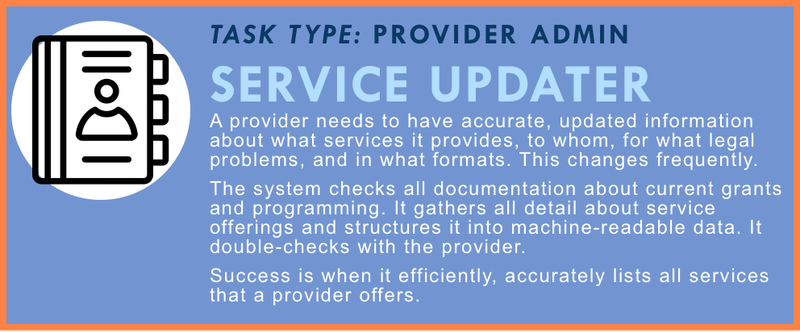Service Directory Maintenance

Help providers maintain an accurate, structured list of their services by gathering and updating details from internal documentation and program materials.
Task Description
Legal help providers offer a wide range of services—brief advice, full representation, clinics, workshops, hotlines, document prep, referrals, and more. These services vary by issue area, location, delivery format, and eligibility. Keeping an up-to-date record of all services—and sharing it in a machine-readable way—is essential for intake, referrals, funding compliance, and public information, but it’s also a time-consuming task.
This task focuses on a system that serves as a service inventory assistant and structuring tool. It reviews a provider’s internal documentation—such as grant reports, program brochures, internal wikis, websites, and CMS notes—to identify the full list of services currently offered. It extracts relevant data points (e.g., legal issue areas served, formats, delivery methods, eligibility restrictions, contact methods) and organizes them into a structured, reusable format.
The system then presents this structured inventory to staff for review and confirmation. It flags any outdated or inconsistent entries, proposes updates, and allows staff to make edits directly. It also supports standard data schemas used in legal referral networks and statewide directories, making it easier to publish or sync the data with public-facing tools.
This tool is especially valuable for programs managing multiple grants, delivery models, or evolving services, and for statewide referral systems that depend on accurate routing data. It ensures that directories, triage tools, and reporting systems reflect reality—without requiring constant manual upkeep.
Success means that the provider ends up with a complete, accurate, and machine-readable inventory of all services they offer, updated more efficiently than manual methods.
Ideally, a tool will help orgs for these sub-tasks:
- Tracking and updating organization details: name, contact, website, language capacity
- Maintaining eligibility rules and intake criteria for services
- Certifying or flagging inactive or duplicate resources
- Possibly creating federated directories that sync across jurisdictions and platforms
Primary audiences: Website admins, program managers, intake and triage designers, public navigators
Quantitative Summary of Stakeholder Feedback
- Average Value Score: 4.26 (High)
- Collaboration Interest: 4.00 (High)
This cluster ranks in the top 3 for both value and collaboration interest. Maintaining accurate service directories is widely acknowledged as essential—and very difficult to sustain manually.
Existing Projects
Numerous fragmented tools exist, but many lack centralized AI support:
- Pro Bono Net’s LawHelp Directory (used in many states)
- JusticeServer, LegalServer, and Salesforce-based CRMs with resource libraries
- North Carolina’s “Guide” backend
- Manual Airtables or Google Sheets in smaller jurisdictions
- Experimental scrapers to detect dead links or changed info
“I’m not aware of any AI tool that does this well, but we’ve built partial logic into our CMS.”
“We’ve used Airtable to track updates manually, but it’s not sustainable.”
Stakeholder Commentary
This cluster sparked strong, pragmatic interest:
- Most legal help platforms struggle to maintain service listings, especially across rural areas and limited-staff nonprofits
- AI could help detect outdated listings, autofill missing info, and suggest edits
- Some skepticism about sourcing eligibility logic in a machine-readable format
“Maintaining addresses, names, phone numbers, and intake requirements is a full-time job. AI could help a lot.”
“It would be extremely useful, and I think AI could actually be better than humans at some parts of this.”
“I don’t know how this would work—eligibility is a mess, and it changes all the time. But I want the tool.”
How to Measure Quality?
📋 Coverage and Completeness
- Captures all major services currently offered, including emerging or grant-specific programs
- Includes relevant metadata for each service: legal issue, audience, delivery format, languages, location, eligibility, schedule
- Flags missing or ambiguous data for staff to resolve
🔍 Source Alignment and Extraction Accuracy
- Pulls from approved internal documentation sources: grant reports, websites, CMS fields, intake forms, service brochures
- Detects and consolidates duplicate or outdated entries
- Extracts correct eligibility criteria, geographic scope, and legal focus areas
🧠 Structuring and Schema Compatibility
- Organizes services using standard taxonomies or schemas (e.g., LIST, Open Referral)
- Supports tagging, filtering, and syncing to external systems or directories
- Links services to relevant programs, grants, or funding requirements
🔁 Provider Review and Customization
- Presents findings to providers in a readable, editable dashboard or interface
- Allows corrections, additions, and confirmation before publishing or syncing
- Tracks version history and staff decisions on changes
⚙️ Automation and Update Efficiency
- Can be re-run as programs evolve or grants change
- Suggests updates when source materials are revised or new services are launched
- Reduces time required for manual data entry or reformatting
🔐 Transparency and Auditability
- Logs where each service entry was pulled from and when
- Supports exports for grant reporting, public-facing use, or partner syncing
- Maintains compliance with privacy and data-sharing protocols
Stakeholders shared clear performance indicators for this task:
- Update frequency: how often is the info refreshed and verified?
- Dead link rates and bounce rates
- Accuracy of eligibility matching
- Provider feedback: do they feel accurately represented?
“It’s doing a good job if users are sent to organizations that are actually taking clients.”
“We should track not just usage but successful connections.”